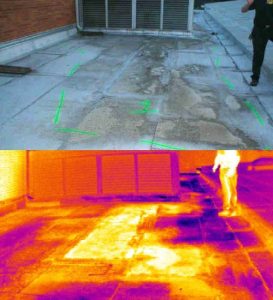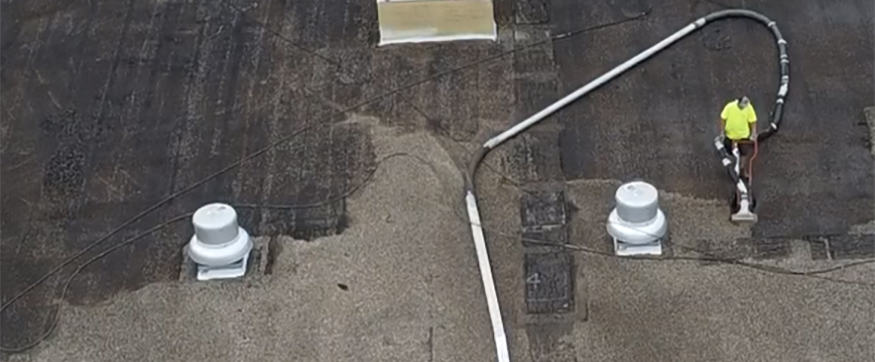The most cost-effective way to remove loose gravel from a commercial roof is to “wet vacuum” it.
If you’re unaware of wet vacuuming, it’s a large vacuum that picks up loose gravel and uses pressurized water to clean the roof.
You might have other questions, such as:
- Why do you need to remove the loose gravel?
- How much does it cost?
- Are there other alternatives?
And just so you’re aware, West Roofing Systems has been in commercial roofing since 1979. We’ve seen hundreds of roofs with loose gravel on them. Property owners are usually shocked when we tell them that we can vacuum the rocks off.
Why does loose gravel need to be removed?
Reason #1 – To determine the location of leaks
It’s impossible to locate leaks when there’s loose gravel everywhere.
Once you remove the gravel, a contractor can perform specific tests, such as pulling core samples or performing an infrared scan. These tests will determine if there’s water in the insulation.

Regardless of which roofing system you will install, all the wet insulation should be removed before installing a new one.
Reason #2 – Not advised to secure a roof system to loose gravel
You may think, of course you can’t put a roof over loose gravel. Unfortunately, some do it.
Some contractors will reduce the project costs by skipping the gravel removal process. They think laying a board down over the loose gravel will give them an excellent base to install another roofing system.
There are some problems with this.
One is that the loose gravel will shift, become jagged, and deteriorate the bottom of the board.
We’ve seen sawdust remains from a coverboard on roofs installed like this. When this happens, the board loses R-value, and the roof’s slope is thrown off.
Energy costs can rise if R-value is reduced. And if the roof’s slope is off, ponding or standing water can occur, degrading the roof’s overall life.
How much does it cost to remove loose gravel from a roof?
The ballpark cost to remove loose gravel from a roof is $0.55 – $1.10 per square foot. Many variables influence cost, such as:
Thickness/amount of loose gravel
Some roofs have ½ inch of loose gravel; others have a full inch. The more gravel, the more it will cost to remove it.
Square footage of the roof
This has to do with setup and overhead costs. It generally costs the same to set up for a 1,000 sq. ft. roof as it does for a 10,000 sq. ft. roof. The larger the roof, the lower it’ll cost per square foot. The smaller the roof, the higher it’ll cost per square foot.
Flat roof versus one with multiple levels
This has to do with maneuverability. How easily can a wet-vac company move around the roof? If all roof areas are easily reached, then it’s no big deal. If the wet-vac company has to constantly drag hoses and equipment around, this will add to the project’s cost.
Distance away from the wet-vac contractor
Will the wet-vac company have to drive 50 miles to your roof or 500 miles? Gas prices, wear and tear on vehicles, and paying labor for drive time all factor into the cost of gravel removal.
Warning: This doesn’t mean always choosing a wet-vac company closest to you. I’d rather pay a few extra dollars to hire a company that’s further away, knowing the company has a reputation for doing great work.
Height of building
Is your roof 20 feet off the ground or 200 feet? High-rise buildings can cost much more because they need cranes to get their equipment to the roof.
Are there alternatives for wet-vacuuming?
Yes.
You can hire someone to shovel and wheelbarrow loose gravel off the roof. This is highly labor-intensive and will cost much more than simply vacuuming the gravel off.
Then you still need to clean the roof.
The best part of wet-vacuuming is that it removes the loose gravel and uses pressurized water to clean the roof simultaneously.
Conclusion
Now that you know the most cost-effective way to remove loose gravel off your roof, what should you do now?
You may think the best solution is to do a few repairs and add new gravel.
But what if you could skip the process of adding new gravel?
In this article, learn about spray foam roofing and how they’re the best solution for a gravel-built-up roof.


